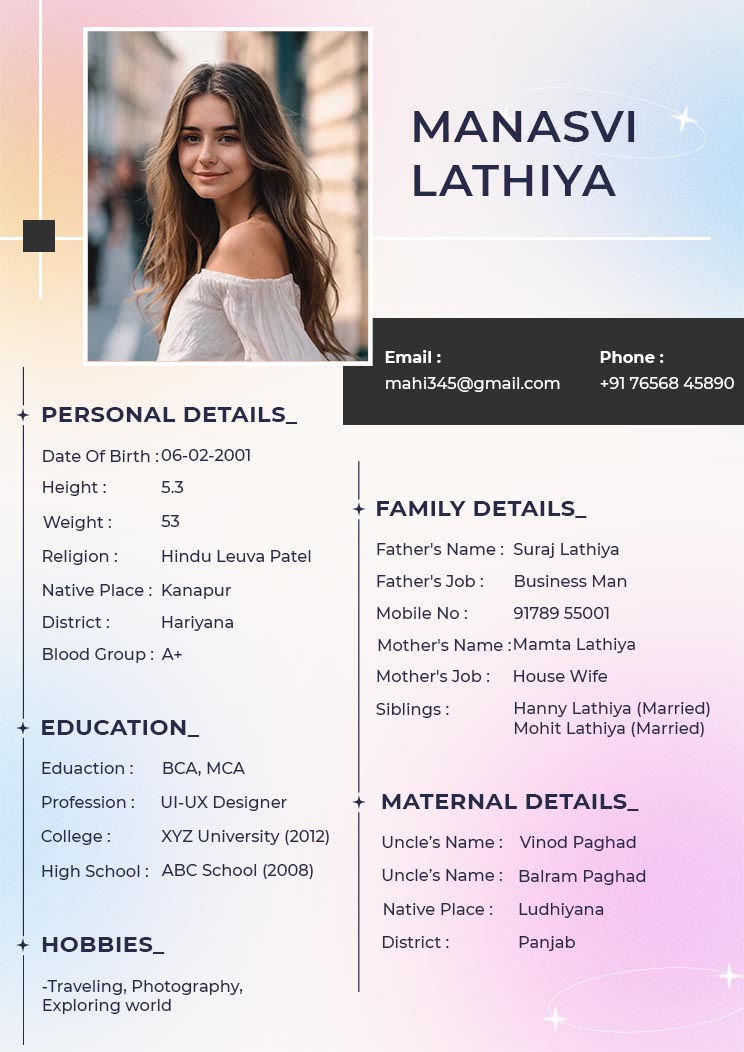In arranged marriages, a biodata serves as a personal profile that helps individuals and families assess compatibility based on shared values, background, and expectations. A well-designed marriage biodata template allows you to structure your information clearly, ensuring that all essential details are covered while presenting your personality and uniqueness.
Why Use a Marriage Biodata Template?
Using a marriage biodata template offers several benefits:
- Saves Time: A template allows you to fill in details quickly and ensures consistency across profiles.
- Covers Essential Information: By following a template, you don’t risk missing crucial details.
- Enhances Presentation: An organized template looks more professional and appealing to potential matches.
- Improves Focus: With a template, you can focus on personalizing the information instead of worrying about structure.
A marriage biodata template serves as a helpful guideline for people who may be new to the process or looking to present their information in a more organized way.
Essential Components of a Marriage Biodata
When creating a marriage biodata, certain components should always be included. Here’s a breakdown of the essential sections in a typical marriage biodata template:
-
Personal Details
- Full name
- Date of birth
- Age
- Height and weight
- Religion and caste (if relevant)
- Languages known
-
Family Background
- Information about parents
- Details on siblings
- Family values and beliefs
- Occupation and education of family members
-
Educational Qualifications
- Highest degree attained
- Schools, colleges, or universities attended
- Notable academic achievements
-
Professional Background
- Current occupation and job title
- Company or organization details
- Previous employment experience
-
Lifestyle and Interests
- Hobbies and activities
- Personal interests (such as travel, art, music)
- Lifestyle preferences, including dietary habits and fitness
-
Partner Preferences
- Age range and physical preferences
- Educational qualifications
- Profession and income preferences
- Lifestyle and family expectations
How to Format Your Marriage Biodata Template
Formatting plays a significant role in how information is received. Here are some guidelines to ensure your marriage biodata is clear and visually appealing:
- Use Headings and Subheadings: Breaking up sections with clear headings helps readers quickly find the information they need.
- Bullet Points for Clarity: For lists, such as family details or hobbies, use bullet points to keep it organized.
- Font Choice and Size: Use a professional font such as Arial or Times New Roman in a readable size (11-12 pt).
- Include White Space: Don’t overcrowd the page; ensure there is enough white space to make the document easy to read.
- Professional Language and Tone: Keep the tone respectful, avoiding humor or informal language.
For more information : invitation of satyanarayan pooja
Tips for Making Your Marriage Biodata Stand Out
- Be Honest but Selective: Share information that’s relevant, but avoid oversharing.
- Add a Personal Touch: A short introductory paragraph can help add personality to your biodata.
- Avoid Negative Language: Focus on positive attributes and achievements.
- Use a Professional Photo: Attach a recent, professionally-taken photo to your biodata for a polished impression.
- Regular Updates: Keep your biodata updated with any new achievements or changes in preferences.
Sample Marriage Biodata Template
Here is a sample template for a marriage biodata. You can customize it to suit your preferences:
Name: [Full Name]
Date of Birth: [DD/MM/YYYY]
Age: [Age]
Height: [Height in cm/inches]
Religion: [Religion]
Caste (if applicable): [Caste]
Languages Known: [Languages]
Family Background
- Father: [Father’s profession, etc.]
- Mother: [Mother’s profession, etc.]
- Siblings: [Number of siblings and their details if needed]
Educational Qualifications
- [Degree, institution, year of graduation]
Professional Background
- Current Occupation: [Job title, organization]
- Previous Experience: [Past jobs if necessary]
Lifestyle and Interests
- Hobbies: [List hobbies]
- Diet: [Dietary preferences]
- Fitness: [Fitness habits]
Partner Preferences
- Age Range: [Age range]
- Education: [Preferred education]
- Profession: [Preferred profession]
- Lifestyle: [Lifestyle expectations]
Common Mistakes to Avoid in Marriage Biodata
- Including Irrelevant Information: Focus only on details that add value.
- Being Vague: Avoid vague statements; provide concrete details.
- Overemphasizing Material Aspects: While financial stability is important, focusing solely on it can seem insincere.
- Using Clichés: Avoid overused phrases like “simple and down-to-earth”; instead, highlight unique aspects.
- Neglecting Presentation: Even a well-written biodata can fail if it’s poorly formatted.
Conclusion: The Importance of a Quality Marriage Biodata Template
A marriage biodata template is an invaluable tool for those entering into arranged marriages. It not only helps in organizing key details but also ensures that your profile stands out in a respectful and appealing way. By following a structured template, focusing on clarity, and highlighting your unique attributes, you can create a biodata that effectively represents you and increases the likelihood of finding a compatible match.

